Named for William Morant, who worked as an official photographer of the Canadian Pacific Railway, Morant’s curve marks a momentous feat of engineering – a ribbon of steel laid through challenging mountain terrain to connect Canada coast to coast.
For visitors interested in exploring the Canadian Rockies and capturing images of its dramatic landscapes, Morant’s Curve represents a convergence of history, nature and photography in a single iconic location.
From the modern Rocky Mountaineer and Via Rail trains to vantage points along the Icefields Parkway, witnessing – and photographing – history in the making as the train rounds Morant’s Curve is a highlight of any Rockies trip!
Table of Contents
Getting to Morant’s Curve
Morant’s Curve is situated along the Bow Valley Parkway between Lake Louise and Banff (closer to the Lake Louise end). It’s free to visit as it’s just a stop along the side of the road! But you will need a Parks Pass, as it’s located inside of Banff National Park.
- From Lake Louise: Take Highway 1A (the Bow Valley Parkway). From here it’s only about a 10 minute drive. There’s no sign, but you’ll be able to see the parking lot across the road from the Curve.
- From Banff: You can also take Highway 1A starting from Banff. Morant’s Curve is about an hour’s drive along the Parkway. (It’s faster to take the Trans Canada Highway that runs parallel to the Parkway, but we always take the scenic route when it’s open!)
- During May, June, and September, the section of the Parkway closest to Banff is closed to vehicle traffic. But you can still access Morant’s Curve from Lake Louise, or turn onto the Parkway from the Trans Canada Highway at Castle Junction.
Regardless of which direction you’re coming from, keep your eyes peeled for wildlife along the Bow Valley Parkway! It’s a great place to see bears, coyotes, pine martens, and if you’re really lucky, even wolves.
Morant’s Curve Map
The location is easily accessible by car, with a small parking area available for visitors. From there, it’s just a short walk to the viewing area.
The Morant’s Curve train schedule is not posted publicly. But if you visit the Curve during regular business hours (Monday to Friday from 9am to 5pm), you have a pretty good chance of seeing a train go by within an hour.
The train does run outside of those times, but you might be waiting a lot longer to see one.
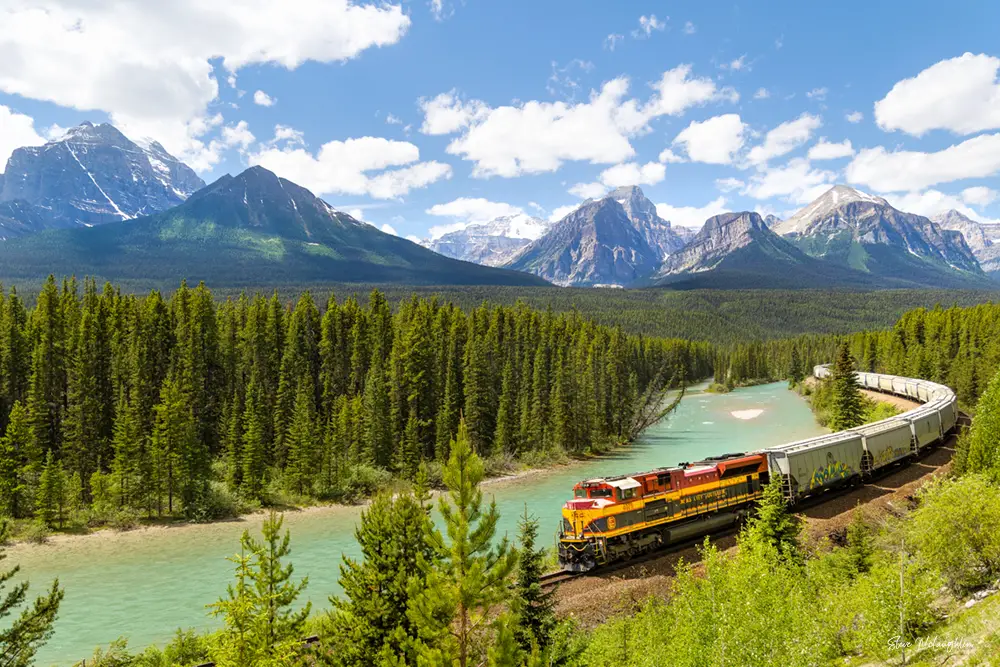
You can find this image and others in our print shop.
Why is it Called Morant’s Curve?
The Curve is named after Nicholas Morant (1910-1999), who spent over 40 years as a photographer with the Canadian Pacific Railway company.
Morant had a lifetime pass to ride the rails any time he wanted, and spent weeks at a time travelling across Canada capturing both the railway itself and the many iconic locations along the way.
Born in Kamloops, British Columbia, he also spent time working with the Winnipeg Free Press and the Wartime Information Branch of the Canadian government during the Second World War. He and his wife Willie called Banff their home for most of their lives.
He was even attacked by a grizzly bear on one of his photography hikes, when he and a guide accidentally came between a mother and cub. Morant slowly recovered, but his friend sadly passed away from complications.
Morant’s iconic images promoted tourism in Western Canada and showcased the beauty of the Canadian Rockies. Some of his pictures appeared on Canadian $10, $50 and $100 bills, as well as postage stamps.
He took tens of thousands of images during his lengthy and adventure-filled career. If you’re visiting the Rockies, stop by the Whyte Museum in Banff, where much of his work still lives.
Morant’s Curve and the Canadian Pacific Railway
The Canadian Pacific Railway (CPR) is a symbol of Canada’s rich history and pursuit of progress. The railway was instrumental in uniting the East and West, connecting its coasts, and facilitating the movement of people and goods across this country’s vast landscape.
The curve is a section of the CPR track that bends around the Bow River, providing a perfect viewpoint to capture the trains as they wind their way through the stunning landscape.
The railway track adds a unique element to the scene, creating a juxtaposition of man-made and natural elements. It’s a reminder of how human ingenuity can coexist with nature, each enhancing the beauty of the other.
Today, Morant’s Curve continues to be a favorite spot for photographers looking to capture the essence of the Canadian West. The trains, the track, and the stunning backdrop come together to create a scene that’s as captivating as it is symbolic.
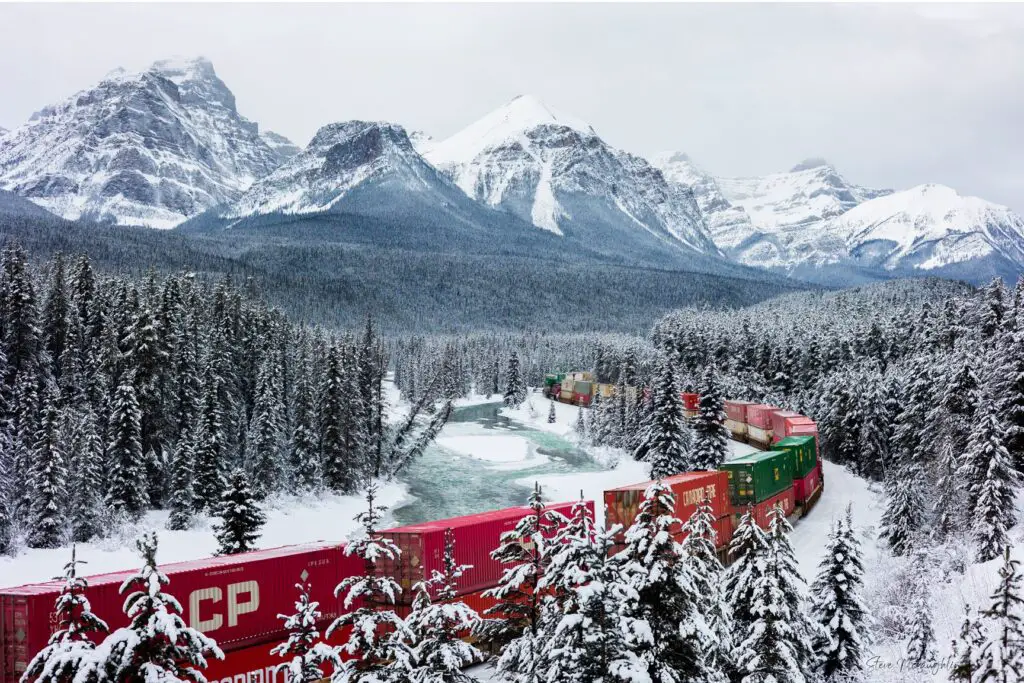
Photographing Morant’s Curve
Photographers from around the world make a pilgrimage to this iconic spot, hoping to capture their own version of the train coming around the corner.
Thanks to the forever changing weather in the Rockies, no two photos of Morant’s Curve are ever the same!
The popularity of Morant’s Curve photography can be attributed to several factors. The stunning natural backdrop, the dynamic element of the trains, and the historical significance of the location all contribute to its allure.
It’s a place where photographers can not only create beautiful images but also connect with a piece of Canadian history.
Tips and Tricks for Capturing the Best Images at Morant’s Curve
Here are some tips to help you get the best shot when you visit this iconic location:
- Timing is Everything: The best time to photograph Morant’s Curve is early in the morning or late in the afternoon when the light is soft and golden.
- Of course, catching the train going by really completes the image! The schedules aren’t posted publicly, but trains are frequent along this route. Grab yourself a coffee and wait for the sound of the train whistle off in the distance – it shouldn’t be too long!
- Composition: Remember the rule of thirds. Position the railway track and the mountains according to this rule to create a balanced composition. Also, consider including elements like the river or trees to add depth to your image.
- Time of Year: Morant’s Curve is absolutely beautiful any time of year, including the winter! Make it a stop on your trip even if you plan to visit in the off season.
- Patience: Lastly, be patient. The perfect shot might require waiting for the right light, the right weather, or the right train. But the result will be worth it.
Morant’s Curve Gifts & Souvenirs
Discover the perfect memento of the iconic Morant’s Curve in our online gift shop! Our locally-printed photography and gifts make ideal souvenirs for train enthusiasts, nature lovers, and anyone who appreciates Canadian mountain landscapes.
Pin This Article!


The Next Stops on Your Trip
- Lake Louise: Just a 10-minute drive from Morant’s Curve, Lake Louise is a definite bucket-list location in the Canadian Rockies.
- Castle Mountain Chalets: Terri always makes us stop at the office/convenience store here to stock up on old school style candy!
- Johnston Canyon Trail: This well-known hiking trail is another 30 minutes down the Bow Valley Parkway from Morant’s Curve (closer to the Banff end). This 6km trail is an easy hike that can appeal to most age groups, and takes about 2-3 hours to complete.
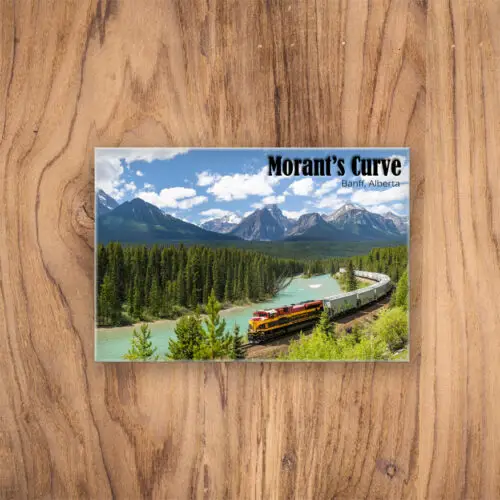
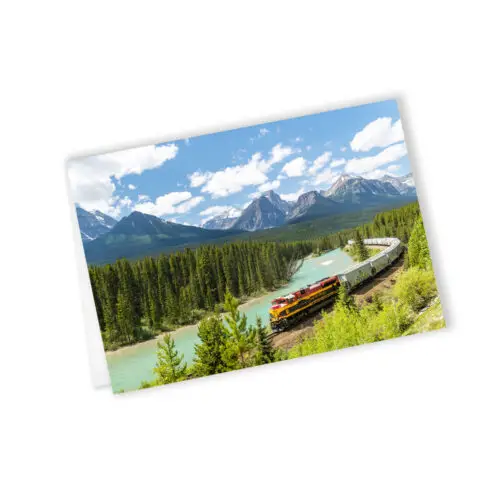

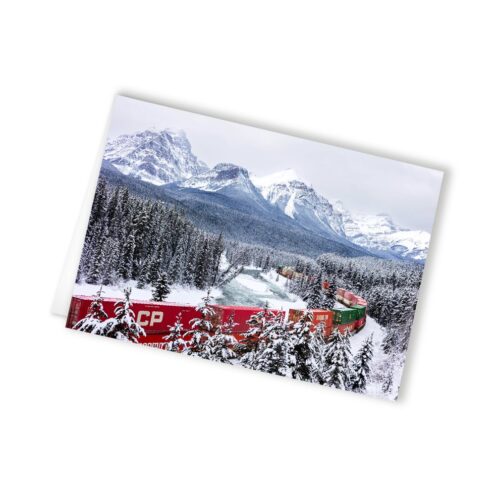
2 comments
Steve, what would it cost for a high res copy of your shot of the KCS locomotive w/ unit grain train on Morants curve? I have a plotter to print it to canvas.
Hi Patrick,
We don’t typically sell the high resolution images but you can find prints of that image here:
https://mountainsandtreasures.ca/product/springtime-at-morants-curve-print/